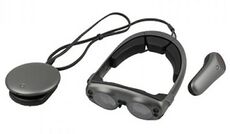Magic Leap 1
The Magic Leap 1 (ML1) is an augmented reality headset from Magic Leap. There are two main versions, called Magic Leap One Creator Edition, and Magic Leap 1.
It has a field of view of 50 degrees (40 wide by 30 tall).[1] It uses diffractive waveguides for its displays.[2]
The Magic Leap 1 blocks out most of the light from the outside world, so it is like wearing sunglasses.
It uses 3D tracking that is camera based and proprietary.
Versions[edit]
- Magic Leap One Creator Edition - Model M9001[3]
- Magic Leap One, Creator Edition - Size 2 - Model M9002[4][5]
- Magic Leap One, Creator Edition - Size 2 - Model M9007[6][7]
- Magic Leap One, Creator Edition - Size 2 - Model M9011[8][9]
There is an updated headset named "Magic Leap 1" that has an Intel Myriad X chip and upgraded IMUs.[10]
Hardware[edit]
The Magic Leap One has three hardware components: The headset, the compute pack, and the controller.
It uses OmniVision's OP02222 field-sequential color (FSC) LCOS modulator.[11]
Headset[edit]
The headset is hardwired into the attached computer. The Magic Leap was made in two sizes, called size 1 and size 2. Size 1 is for IPD less than 65mm. Size 2 is for IPD above 65mm.[12] The headsets came with a variety of forehead and nose pads in the box. Magic Leap also revealed that it’s working on a design that would enable the inclusion of prescription lenses into the goggles.
The headset has multiple sensors and at least six external cameras to gather spatial environmental data for egocentric tracking. The Magic Leap One has built-in speakers and built-in microphones, four of them in the headset. The speakers are low quality. The headset has a higher field of view than the HoloLens 1.
The headset uses four waveguides total. Two per eye: two separate focal planes per eye, that automatically switch based on if the user is focused near or far. It is meant to use eye tracking to determine where the user is roughly focusing, but it has problems. Magic Leap had publicized lightfield technology, but did not use it for the Magic Leap 1.
The headset is referred to from Magic Leap as the "lightwear".
Attached computer[edit]
There is a compute pack called a lightpack.
The computer that powers the headset comes in the form of a compact disc-shaped hip-pack. The gadget comes with a clip-on mechanism to attach to the belt or shoulder pad and is tethered to the headset.
The Controller[edit]
There is a handheld controller that has 3D tracking and buttons on it. It uses magnetic tracking. It is heavy.
The controller tracking is not good. Palmer Luckey wrote that, "For VR enthusiasts who are familiar with systems from Polhemus (the OG magnetic tracker people), the Razer Hydra, or the ever-elusive Sixense STEM, you know where the bar is."[13]
Software[edit]
The Magic Leap 1 runs Lumin OS and is generally locked down to it. The Magic Leap 1 not made to be able to put a custom operating system on it.
The Magic Leap SDK was announced on June 2, 2015 during the MIT Technology Review’s EmTech Digital conference. The SDK is compatible with with both Unity and Unreal game engines. Sign-ups were available on its website.[14] The software on the ML1 has a display cutoff about a foot away. So anything closer gets cut off. Magic Leap claims this is for comfort due to the vergence accommodation conflict.
The Magic leap can be used in a Unity 2018 development environment. Newer versions of unity have dropped support. Magic leap Ones require remote software signing by Magic Leap. A device can be locked, which requires contacting Magic Leap's support to get an unlock code.
There is a program called mldb that runs on a computer that can connect to a Magic Leap 1 connected over USB.[15]
Applications[edit]
There were apps available from an app store, called Magic Leap World.[16]
See List of Magic Leap applications.
- Helio is a web browser that runs on the Magic Leap One series of headsets.[18]
References[edit]
- https://www.magicleap.com/?utm_source=reveal&utm_medium=TW&utm_campaign=WTDO
- https://www.theverge.com/2017/12/20/16800474/magic-leap-one-creator-edition-augmented-reality-goggles-announce
- https://www.wired.com/story/its-time-to-take-magic-leap-seriously/
- https://techcrunch.com/2017/12/20/magic-leap-shows-off-its-magic-leap-one-creators-edition-ar-headset-shipping-in-2018/
- https://www.engadget.com/2017/12/20/magic-leap-one-details-questions-dont-know/
- https://www.rollingstone.com/glixel/features/lightwear-introducing-magic-leaps-mixed-reality-goggles-w514479
- ↑ https://virtualrealitytimes.com/2019/09/21/apples-ios-13-1-beta-code-sheds-spotlight-on-the-ar-headset-field-of-view/
- ↑ Guttag, Karl (2018-09-27). "Magic Leap Review Part 1 – The Terrible View Through Diffraction Gratings". https://kguttag.com/2018/09/26/magic-leap-review-part-1-the-terrible-view-through-diffraction-gratings/.
- ↑ "Deep Dive Teardown of the Magic Leap One Creator Edition M9001 AR Headset". 2017-01-11. https://www.techinsights.com/products/ddt-1810-807.
- ↑ "Magic Leap One Creator's Edition Model # M9002". 2024-04-16. https://www.ebay.com/itm/164946484909.
- ↑ "164946484909 image". https://i.ebayimg.com/images/g/rcEAAOSwoqZfZRle/s-l1600.webp.
- ↑ "Magic Leap One Creator Edition AR Glasses M9007". 2024-05-17. https://www.ebay.co.uk/itm/276470774733.
- ↑ "276470774733 image". https://i.ebayimg.com/images/g/TNUAAOSwFo5mR0EQ/s-l1600.webp.
- ↑ https://www.ebay.com/p/13048001060
- ↑ https://i.ebayimg.com/images/g/TfcAAOSwKihlUQyX/s-l1600.webp
- ↑ "Differences between Magic Leap One Creator Edition and Magic Leap 1". 2021-05-10. https://www.magicleap.care/hc/en-us/articles/360037603251-Differences-between-Magic-Leap-One-Creator-Edition-and-Magic-Leap-1.
- ↑ https://www.ifixit.com/Teardown/Magic+Leap+One+Teardown/112245
- ↑ "[ML1 Sizing"]. 2022-10-05. https://www.magicleap.care/hc/en-us/articles/360008834511--ML1-Sizing.
- ↑ Luckey, Palmer (2018-08-27). "Magic Leap is a Tragic Heap". https://palmerluckey.com/magic-leap-is-a-tragic-heap/.
- ↑ Constine, Josh (2015-05-29), Magic Leap Announces Its Augmented Reality Developer Platform, https://web.archive.org/web/20150603104741if_/http://techcrunch.com/2015/06/02/magic-leap-platform/, retrieved 2024-09-26
- ↑ "Software Configuration and Description: Magic Leap". https://avida.cs.wright.edu/magicleap.html.
- ↑ "Apps on Magic Leap World". https://world.magicleap.com/en-us.
- ↑ https://world.magicleap.com/en-us/details/com.magicleapstudios.create
- ↑ "[ML1 Helio Overview"]. 2022-10-05. https://www.magicleap.care/hc/en-us/articles/4405565569933--ML1-Helio-Overview.

